บรรษัทข้ามชาติกับการส่งออกของประเทศกำลังพัฒนา
การวิเคราะห์ภาคอุตสาหกรรมไทย
Abstract
This paper examines the firm’s export decision and the export spillover from multinational corporations (MNCs), based on the cross-sectional econometric analysis of theThai manufacturing. The key finding is that MNCs tend to be more export-oriented than indigenous firms. In addition, the entry of the former stimulates the latter to involve in export, i.e. presence of MNC export spillover. All other things being equal, firms in industries with high tariff rates tend to be domestic-oriented. The role of government is to provide adequate infrastructure services at the competitive price and create conducive investment climate in order to entice MNCs. Tariff restructuring needs to be continued to neutralize incentive structure between
domestic sales as opposed to export.
References
2. Akira, S. (1989), Capital Accumulation in Thailand 1855–1985, Bangkok: Silkworn Books.
3. Athukorala, P. (2003), ‘Product Fragmentation and Trade Patterns in East Asia’, Working Papers in Trade and Development No. 2003/21, Canberra., Australia.
4. Athukorala, P. (2006), ‘Multinational Production Networks and the New Geo-economic Division of Labour in the Pacific Rim, Working Papers in Trade and Development No. 2006/9, Canberra., Australia.
5. Athukorala, P., S. Jayasuriya and E. Oczkowski (1995), ‘Multinational Firms and Export Performance in Developing Countries: Some Analytical Issues and New Empirical Evidence’, Journal of Development Economics, 46, pp.109–122.
6. Athukorala, P. and K. Sen (1998), ‘Processed Food Exports from Developing Countries: Patterns and Determinants’, Food Policy, Vol. 23, No.1, pp.41–54.
7. Athukorala, P. and S. Jayasuriya (2003), ‘Food Safety Issues, Trade and WTO Rules: A Developing Country Perspective’, World Economy, Vol.26, No.9, pp.1395–1416.
8. Balasubramanyam, V.N., M.A. Salisu, and D. Sapsford (1996), ‘Foreign Direct Investment and Growth in EP and IS Countries’, Economic Journal, 106 (434), 92–105.
9. Baldwin, R.E. (1988) ‘Hysteresis in Import Prices: The Beachhead Effect’, American Economic Review, 78 (4), pp. 773-785.
10. Baldwin, R.E. and P. R. Krugman, (1989) ‘Persistent Trade Effects of Large Exchange Rate Shocks’, Quarterly Journal of Economics, 104 (4), pp.635-654.
11. Barrios, S., H. Gorg, and E. Strobl (2003), ‘Explaining Firms’ Export Behavior: R&D Spillovers and the Destination Market’, Oxford Bulletin of Economics and Statistics, 65, pp. 475-96.
12. Bernard, A. and J. Jensen (1997), ‘Why Some Firms Export: Experience, Entry Costs, Spillovers, and Subsidies, Yale University (mineo).
13. Bernard, A. and J. Jensen (1999), ‘Exceptional Exporter Performance: Cause, Effect, or Both’, Journal of International Economics, Vol. 47, pp.1-25
14. Berndt, E. (1991), The Practice of Econometrics, Addison-Wesley, MA.
15. Cook, R. D. (1977), ‘Detection of Influential Observation in Linear Regression’, Technometrics, 19 (1), pp. 15–19.
16. Dixit, A. (1989), ‘Entry and Exit Decisions Under Uncertainty, Journal of Political Economy, 97 (3) pp. 620-638.
17. Feenstra, R. (2004), Advanced International Trade: Theory and Evidence, Princeton University Press, Princton.
18. Greenaway, D. N. Sousa, and K. Wakelin (2004), Do Domestic Firms Learn to Export from Multinationals?, European Journal of Political Economy, 20, pp.1027-1043.
19. Hahn, C. H. (2004) ‘Exporting and Performance of Plants: Evidence from Korean Manufacturing’, NBER Working Paper 10208, National Bureau of Economic Research (NBER), Cambridge.
20. Helleiner, G.K. (1988), ‘Direct Foreign Investment and Manufacturing for Export in Developing Countries: A Review of the Issues’, in S. Dell (ed.) Policies for Development, Macmillan, London.
21. Hill, H. and P. Athukorala (1998), ‘Foreign Investment in East Asia: A Survey’, Asian-Pacific Economic Literature, 12 (2), 23–50.
22. Hone, A. (1974), ‘Multinational Corporations and Multinational Buying Groups: Their Impact on the Growth of Asia’s Exports of Manufacturers: Myths and Realities’, World Development, 2, pp.41-46.
23. Ito, K. (2004), ‘Foreign ownership and plant productivity in the Thai Automobile Industry in 1996 and 1998: A Conditional Quantile Analysis’, Journal of Asian Economics, 15 (2), p.321-353.
24. Kessing, D.B. (1983), ‘Linking up to Distant Markets: South to North Exports of Manufactured Consumer Goods’, American Economic Review, 73, pp.328-42.
25. Kohpaiboon, A. (2003). Foreign Trade Regime and FDI-growth Nexus: a Case Study of Thailand, Journal of Development Studies, December, pp. 55.69
26. Kohpaiboon, A. (2006a), ‘Foreign Direct Investment and Technology Spillover: A Cross-industry Analysis of Thai Manufacturing’, World Development, March, pp.541-556.
27. Kohpaiboon, A. (2006b), Multinational Enterprises and Industrial Transformation: Evidence from Thailand, Edward Elgar, Cheltenham.
28. Kokko, A., M. Zejan and R. Tansini (2001), ‘Trade Regimes and Spillover Effects of FDI: Evidence from Uruguay’, Weltwirtschaftliches Archiv, 137, pp. 124–149.
29. Lipsey, R.E. (1999), ‘ Affiliates of US and Japanese Multinationals in East Asian Production and Trade’, NBER Working Paper 7292, National Bureau of Economic Research (NBER), Cambridge.
30. Ramstetter, E.D. (2004), ‘Labour Productivity, Wages, Nationality, and Foreign Ownership Shares in Thai Manufacturing 1996–2000’, Journal of Asian Economics, 14, No.6, pp.861–884.
31. Richardson, G.B. (1972), ‘The Organization of Industry’, Economic Journal, 82, pp.883–96.
32. Roberts, M.J. and J.R. Tybout (1997), ‘The Decision to Export in Columbia: An Empirical Model of Entry with Sunk Costs’, American Economic Review, 87 (4), pp.545-564.
33. Toni, A.D. and G. Nassimbeni (2001), ‘The Export Propensity of Small Firms: A Comparison of Organisational and Operational Management Levers in Exporting and Non-exporting Units’, International Journal of Entrepreneurial Behaviour and Research, 7 (4), pp. 132-147.
34. Wooldridge, J. M. (2002), Econometric Analysis of Cross Section and Panel Data, Cambridge: MIT Press.
35. World Bank (1993), The East Asian Miracle: Economic Growth and Public Policy,Oxford University Press for the World Bank, Washington DC.










